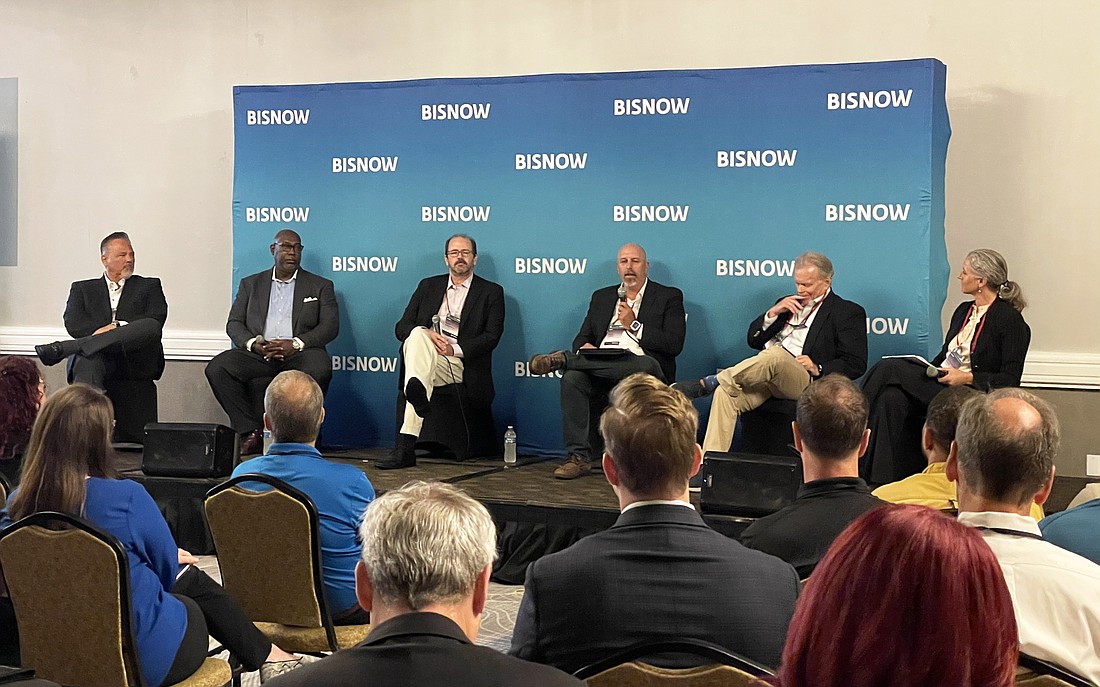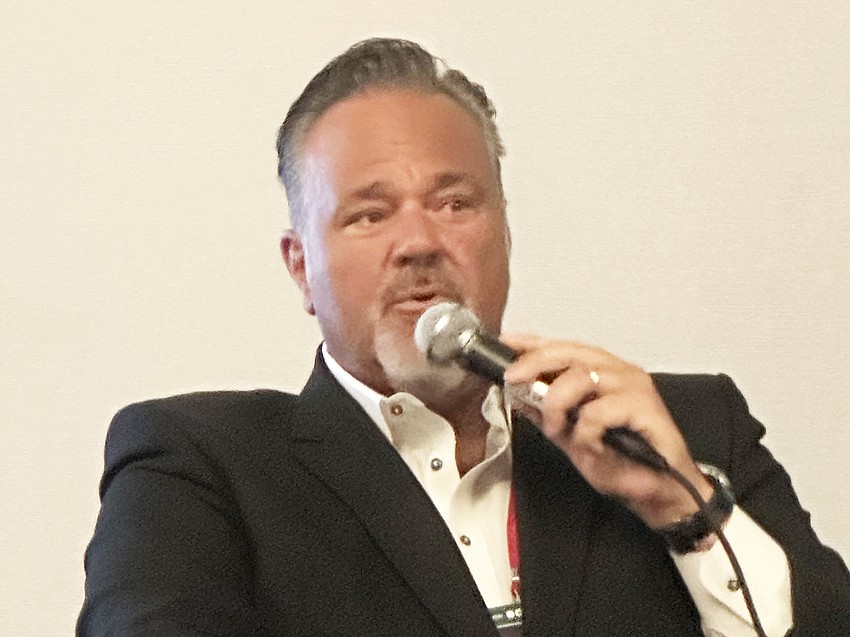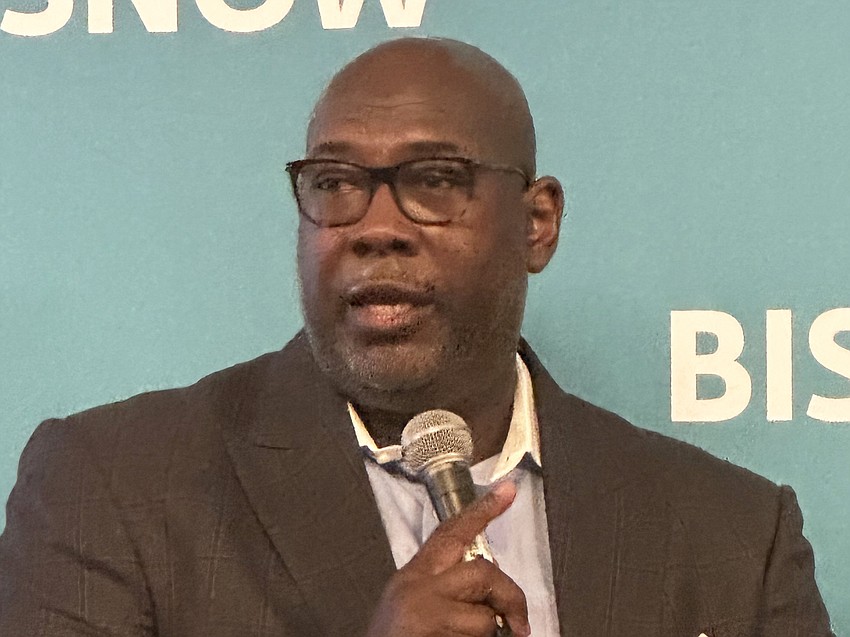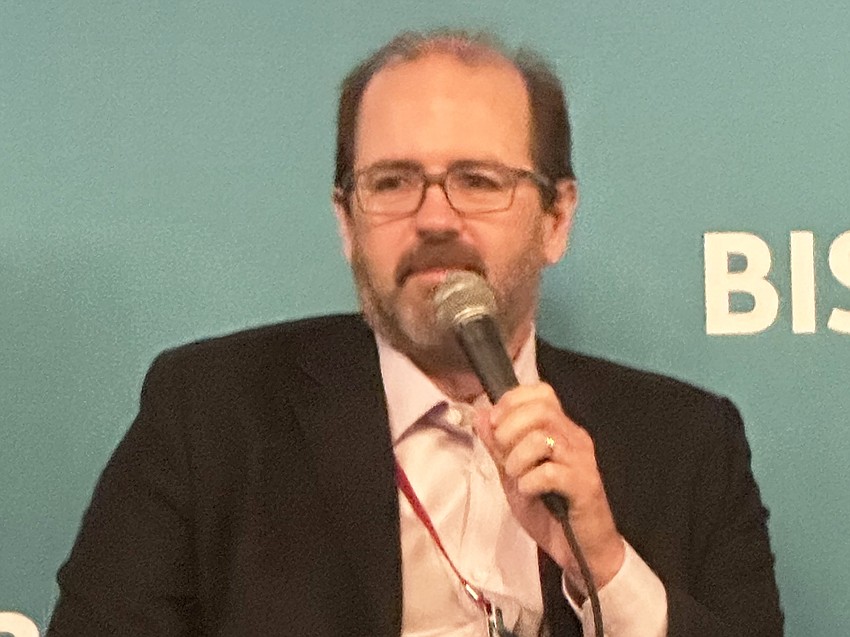
What do Sam Zell, the Landing, a record residential sale in Ponte Vedra Beach and snippets of salty language have in common?
They all were part of almost 90 minutes of insights into Northeast Florida commercial real estate by area developers, builders and investors.
Bisnow, a Washington, D.C.-based digital media company that reports about the commercial real estate industry and sponsors events, hosted “Building the Future” on Aug. 1 at the Southbank Hotel Jacksonville Riverfront.
The remaining part of the title was “Navigating Global Events and Trends that are Changing the Landscape of CRE Construction and Development in Jacksonville.”
Moderated by Gunster shareholder Julia Holden Davis, the panel comprised Jason Carnes, vice president of commercial at Caddell Construction; Matt Marshall, senior vice president of development for RISE: A Real Estate Company; Michael McNaughton, COO of Sleiman Enterprises; Mark Scott, partner of Industrial Real Estate Solutions, Foundry Commercial; and Aundra Wallace, president of the JAXUSA Partnership economic development division of JAX Chamber. About 100 people attended.
This is an edited summary.
With 84 people a day moving into the JAXUSA Partnership’s seven-county region of Baker, Clay, Duval, Flagler, Nassau, Putnam and St. Johns counties, the JAX Chamber says another 152,000 to 158,000 people will be joining the area over the next five to six years.
Newcomers make quality-of-life decisions, such as school districts, including St. Johns at No. 1 in the state, Nassau at No. 2 and Clay at No. 10 out of Florida’s 67 counties. That’s where residential growth tracks.
The area’s economic development “ecosystem” includes advanced manufacturing, transportation logistics, life sciences, technology services, financial technology and corporate relocations.
Pre-pandemic, office-related prospects led warehousing 60% to 40%, but with port dredging for more ship traffic and other factors, that has flipped warehousing logistics to 65% or 70%.
So far this year, JAXUSA has announced 11 projects pledging 1,600 jobs and $1.9 billion in capital investment.
With industrial space tight in Duval, neighboring counties are creating warehouses and attracting projects and jobs.
Wallace said international prospects include autonomous electric vehicle manufacturing, health innovation technology, biopharmaceuticals, medical device innovations and life sciences.

Key quote: Mark Scott
“From the standpoint of industrial real estate, we started the year with about 9 million square feet under construction that was going to deliver by the first quarter of next year. Well, half of that’s already completed, and most of that’s already leased.
“It’s all types of users. It’s the biggest box user you can think of. It’s regional distribution, and it’s a local company that’s been needing to expand their business.
“I’ve been doing industrial real estate in this market for 34 years, and the last four years are without question the most dynamic period in the industrial market in Jacksonville, Florida. And right now, barring some cataclysmic upheaval, I think it continues for the near term.”
Development had been local-dollar-driven but the area has drawn national and international interest.
Headwinds began about 2019 as the pandemic loomed, then triggering shutdowns followed by policy changes after the 2020 presidential election.
Consumer demand stayed strong as production strained to meet those needs during the COVID lockdown.
All that led to tightening labor markets, rising labor costs and interrupted supply chains, driving up inflation. The Federal Reserve responded by raising interest rates, leading to higher borrowing costs.
Construction materials that previously arrived in two months then took eight months to a year.
Those factors challenged developers’ ability to put together deals.
Deals can be lost, such as when a fast-casual restaurant opts to renovate a former dining site rather than build a new one. Northeast Florida shopping centers are seeing historically high occupancy rates.
Retail development follows population and housing growth, so home and apartment construction precedes new stores and shopping centers, especially supermarkets and neighborhood retailers and services.
Northeast Florida areas that include St. Augustine and Ponte Vedra Beach are becoming less seasonal and are attracting visitors and residents year-round as people move from California, Montana, Texas and other states.
Jacksonville is becoming a larger “meganode” like Tampa and St. Petersburg. Lines are blurring among counties, especially Duval and St. Johns as population growth moves south along Interstate 95.
Population also is moving north from Miami-Dade County seeking lower costs of living in less congested areas, such as Ocala and Jacksonville.
That brings wealth, too.
To underscore that type of investment, an oceanfront home in Ponte Vedra Beach recently sold for a record $16.25 million, or $2,100 per square foot.
More people drive the need for goods, services, distribution and logistics.

Key quote: Michael McNaughton
“I had the opportunity to have breakfast with a guy named Sam Zell almost 30 years ago, and he said, Michael in your career, everyone’s gonna tell you it’s location, location, location. He said that’s f----g b----t. It’s timing, timing, timing, and he said the smart real estate person knows when the right time is.
“Those words have stuck with me. Everything is about timing. And I think North Florida’s time is now.”
The self-made Zell was considered the forefather of real estate investment strategy. The Chicago billionaire died in May 2023 at the age of 81.
The area is attracting talent through job recruitment and population growth. It is “growing” talent within the school system, K-16 and beyond.
The challenge is bringing back area students who leave the region for college or training.
Those young professionals can end up in Orlando or other cities that compete with Jacksonville for corporate relocation and business expansion.
The challenge is to produce an environment that attracts them back to Jacksonville, as well as a school system that creates the skills needed by employers.
It also leads to a sense of urgency to complete deals to create those jobs and “cool” housing, attractions and amenities, including Downtown.
At an average age of 38 to 39, Northeast Florida is the second youngest region in Florida, behind Orlando. The average age statewide is 43.
The potential University of Florida graduate campus in Jacksonville for health and financial technology is considered a critical addition to build on what is offered by existing colleges and universities.

Key quote: Aundra Wallace
“When we look at companies, the No. 1 criteria for the company to choose our region is, do you have the availability of the talent at a cost-effective price point that’s cheaper than any of your other competitor cities? That’s what we have to fight against every day.”
Affordable housing is considered “the elephant in the room” in most cities, where employees making 70% to 120% of the average median income cannot afford housing, especially near their jobs.
Developers say they are at the mercy of construction costs and interest rates in determining rents.
This year, Florida created the Live Local Act through Senate Bill 102 as an affordable housing push that municipalities will work through. It provides developers with incentives to construct affordable and workforce housing throughout the state.
Cities and developers need “the intestinal fortitude” to acknowledge the need.
Cities can inventory their publicly owned real estate and price it for affordability, but it must produce a return on investment for developers to produce quality, attainable housing.
People moved to Jacksonville during the coronavirus pandemic lockdowns who could work remotely.
That along with area employees who follow a hybrid schedule led to specifically developed cowork offices in shopping centers, office buildings or community clubhouses.
Apartment developers are adding individual workspaces and conference centers that tenants can book.
Shopping center developers and office landlords added tenants that specialize in creating cowork space for rent.
Companies, primarily office users, are trying to lure employees back to their workplaces by adding amenities from game rooms to free food to fitness centers and more. Some office towers are converting entire floors into space for lounges, conference space, golf simulators and coffee bars.
Employers want employees back at the office for at least several days a week to cultivate the corporate culture, which Wallace said is “hard as hell” to embed over Zoom.
Employers now are facing lease renewals and must factor in the status of their on-site workforce, leading to decisions about downsizing space or adding amenities.
Office building owners are considering how to reuse the vacancies.

Key quote: Matt Marshall
“If we take an attitude that we want to just be traditionalist, and we always just want people to work (in) the office, I think we’re going to run into a real wall with the younger population because they want that autonomy. They want to do a three day-two day or four-and-one or whatever combination is so highly important that developers at least from a residential side, embrace that and try to figure out what works for them.
“The developers that realize that, digest it, understand it and embrace it will be on the front of that.”
Historic preservation and restoration can be expensive and time-consuming, and not all developers can do it.
The projects typically need public investment while often facing community calls to hang onto the structure because of its link to the past.
Developers determine their margins on the project and whether they can afford to preserve it. Without public support, the property could remain vacant for much longer.
Properties that are not historic can more easily be reused, such as a former retail store becoming a self-storage center or a hotel converting into housing.
RISE is developing the RISE Doro site into a 247-unit, mixed-use, residential project in the Sports & Entertainment District with the support of the Downtown Investment Authority.
A more than 100-year-old building and other structures on the 2-acre site drew requests to preserve the building or at least one of its facades.
Marshall said it didn’t make financial sense to do either.
Key quote: Matt Marshall
“We decided we would take one corner of our building and we would design it to mimic what the door or building used to look like - the white brick, the green trimmed windows - and we’re going to do a nice plaque to discuss what the building was, who owned it, how did they use it. A little plaza at the corner is going to be dedicated to the historical use of that property.
“That was our attempt at trying to bridge the gap while controlling costs but yet still paying respect.”

Key quote: Jason Carnes
“The public sector playing a vital role in donating and leveraging your real estate holdings is critical. We’re a growing community. There’s a need for parks and recreational space. We see it Downtown at the old Landing site. The commitment from the public sector to work with the private developers to pull these kind of projects together (is necessary), otherwise it just doesn’t work.”
Key quote: Michael McNaughton
“I think public-private partnerships are very powerful. But there’s a fourth P and that’s pitfall and as a person that worked with The Rouse Company, I have worked on every single festival marketplace they ever built, including when I moved here (the Landing). And I can tell you municipal public-private partnerships are tricky because they involve politics.”
Also: “Unless you have three viable day parts - a residential base, an office population and tourism - it cannot survive.”
Insurance costs have doubled and tripled depending on the project’s location and can decrease the value of an asset by millions of dollars “at the stroke of a pen.”
Developers and owners cannot control hurricanes and other natural events, but if developers cannot find affordable insurance, it will stop growth.
Insurance cost increases affect rents to tenants, who pass increases on to customers.